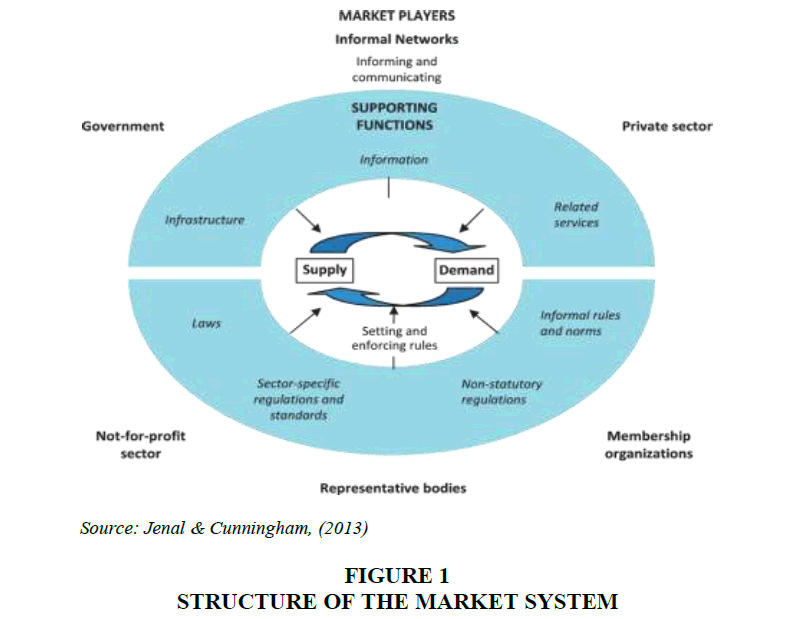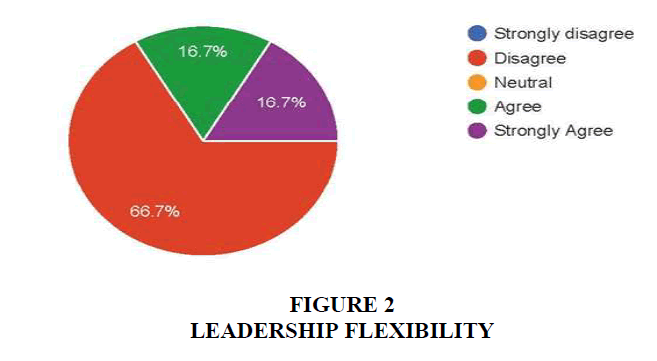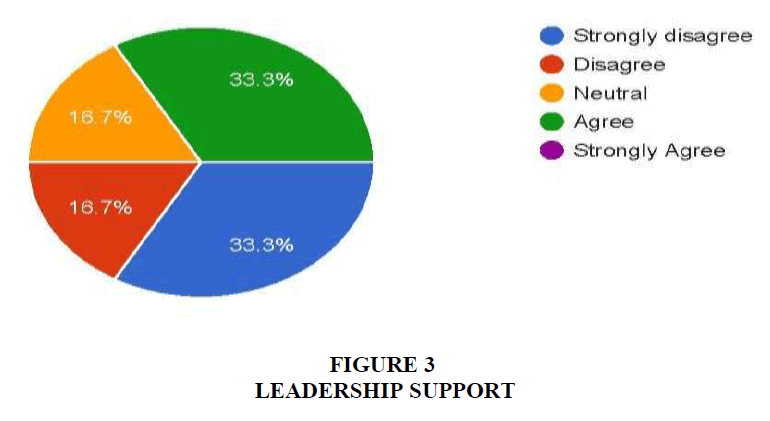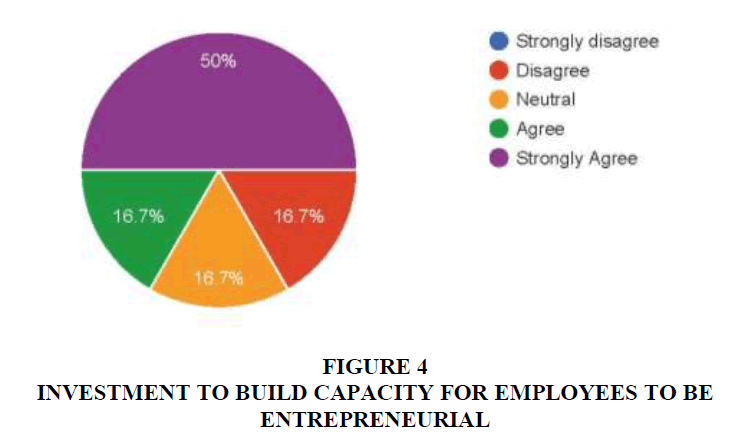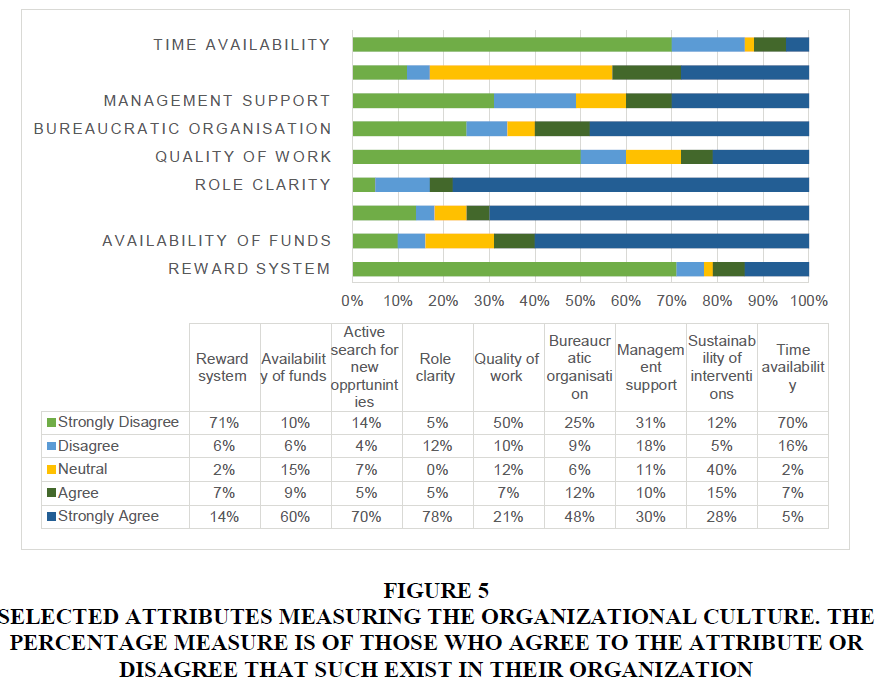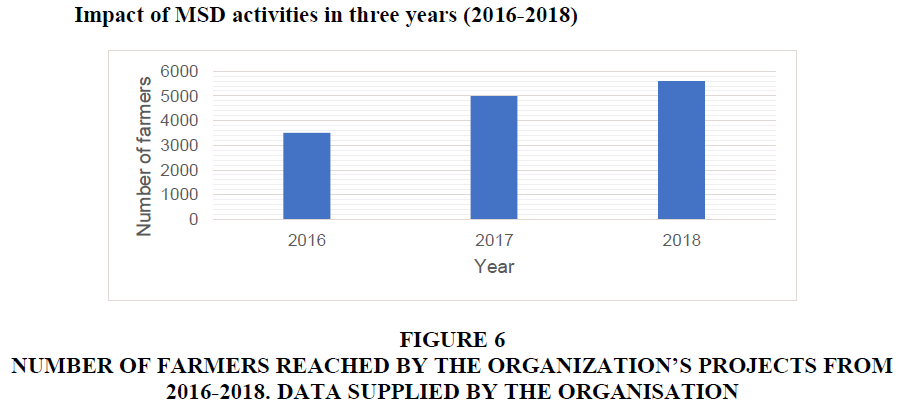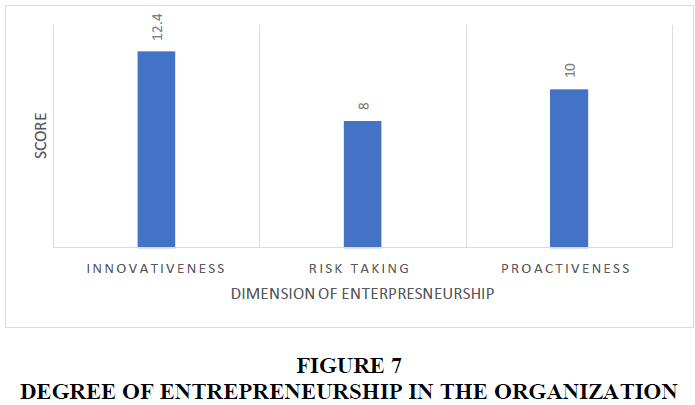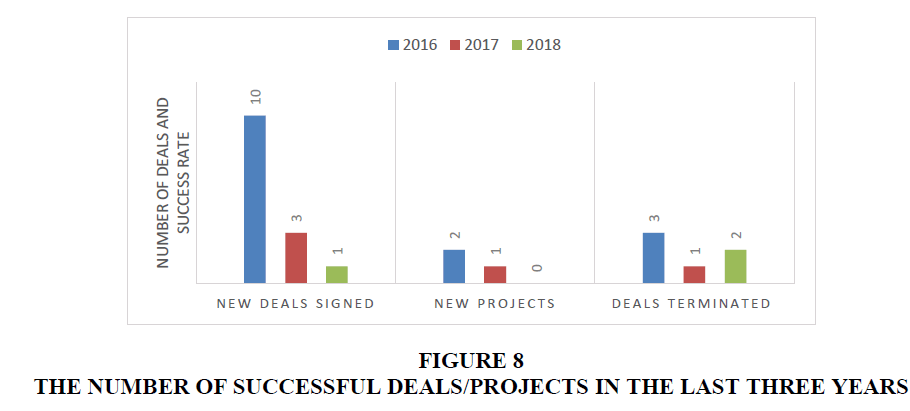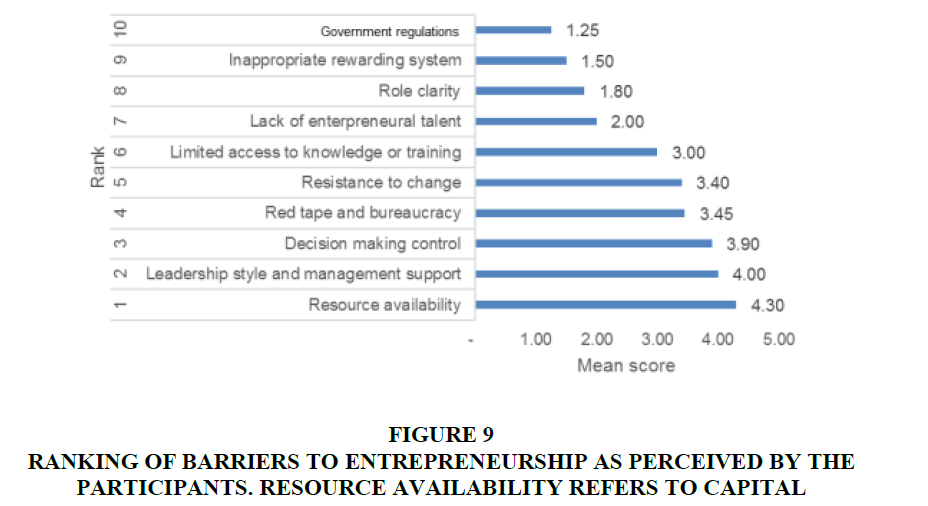Research Article: 2021 Vol: 27 Issue: 2
Corporate Entrepreneurship Culture A Case Study of A Market Systems Development Organization in Mozambique
Caiphas Muyambo, University of KwaZulu-Natal
Vuyokazi Mtembu, University of KwaZulu-Natal
Abstract
Corporate entrepreneurship (CE) is the process by which organisations create value through introduction of new products, services or processes to ensure competitive advantage. Whilst entrepreneurship is such an important subject and crucial for organisational performance, most market systems development (MSD) organisations have not adopted an entrepreneurial posture in their quest to transform market systems to work better for the poor. The objective of this study was to explore and understand the role and impact of corporate entrepreneurship in MSD organisations. The study was conducted at an agriculture and market systems development organization in Mozambique. The organization had a total of 20 employees; since the population size was small a census survey technique was adopted for the quantitative study, followed by a snow ball volunteer sampling technique for the qualitative part of the study. The survey was conducted online using Google Forms and the qualitative study was undertaken using telephonic structured interviews. Data analysis was computed using Microsoft Excel and Statistical Package for the Social Sciences (SPSS). The Grounded theory method was used to analyse qualitative data. It was found that the organisation had a mechanistic structure, characterised by bureaucracy and rigid decision-making control. Even though the level of entrepreneurship was 10 out of 15, other strategic factors such as resource (or capital) availability, leadership and management support and decision-making control were found to be the main barriers to entrepreneurial behaviours. It was recommended that the leadership ought to focus on addressing key variables that prohibit entrepreneurship.
Keywords
Corporate Entrepreneurship, Market Systems Development, Organisational Culture, Sustainability.
JEL Codes: Q01, Q13 and M13.
Introduction
Poverty in Africa is one of the main challenges that governments must address (Williams, 2005; Godfray et al., 2010). To address poverty and underdevelopment, several development organisations exist to promote efficient market systems. The problem is; organizations implementing MSD initiatives have not prioritised and operationalized systems and processes that promote the development of entrepreneurial skills (Ulleberg, 2009; Smith et al., 2012; Batti, 2013; Brière et al., 2015; Vögeli & Icka, 2017). This is a notable gap. It is apparent that the role of CE in these organisations is generally overlooked. The challenge, however, is that in most economies, (including African economies) the economic growth and the markets are not efficient and inclusive (Moores & Hunter, 2018). The poor are generally excluded. Thus, they have no direct means to benefit as development and all growth becomes concentrated in elite groups. This article will look at the role of an MSD organization in Mozambique with regards to promotion of an entrepreneurship culture for poverty alleviation. Mozambique, a scenic country in south-eastern Africa, it is a country rich in natural resources, is biologically and culturally diverse, and has a tropical climate (brittanica.com) Agriculture and tourism are the main role players in the economy of Mozambique, agriculture is particularly important because most of the people living in poverty rely on agriculture to sustain their livelihoods.
The responsibility of MSD organisations is therefore to creatively find ways of empowering local poor communities for them to effectively participate in the value chains of various market systems. The following are objectives of this study:
- To examine the entrepreneurial culture and role of leadership in the organization and their impact on performance and employee perception.
- To examine the main constraints faced by development organization to embed corporate entrepreneurship behaviours
- To determine the level of entrepreneurship, in terms of how pro-active, risk taking and innovative the organisation is.
- To examine the impact of the current organisational culture on the quality and sustainability of work done by the MSD organisations.
- To make recommendations on how Market Systems Development organisations can embed a corporate entrepreneurship culture.
- Results will be presented through the following variables adapted from the objectives of this study: leadership, organizational culture, level of entrepreneurship, employee perceptions, quality of work, sustainability, barriers to entrepreneurship and opportunities for growth.
Literature Review
Corporate Entrepreneurship
Corporate entrepreneurship is about organizational behaviours that seek to develop, generate and implement new ideas to continuously create sustainable value. It is manifested through two forms, namely corporate ventures (CV) or strategic entrepreneurship (Kuratko, 2010) Corporate venturing involves creating, adding or investing in new businesses (Kreiser et al., 2013). It can be accomplished through: (i) internal corporate ventures (where new businesses are formed from pre-existing structures and housed in or outside the existing structures); (ii) joint venture (where a new business is formed in collaboration with an external development partners; and (iii) external corporate venture (where a corporation acquires a business that was established by external parties – normally growth stage firms). Most businesses are grown through a hybrid system of involving both CVs and strategic entrepreneurship activities. The choice of which form of CE to take depends on opportunities available. But the business model of MSD organizations seems to be aligned with strategic entrepreneurship. The subject of entrepreneurship has been broadly studied over the years and the concept has evolved as new understanding came to the fore. Historically, entrepreneurship was viewed from an individual perspective, but Miller (1983) shifted the discussion from individual capability to organization Entrepreneurial Orientation (EO). Entrepreneurial orientation is a strategic posture of an organization and it is related to basic policies and practices that the organization employees use for creation of value (Martens et al., 2018). This shift puts the responsibility to the executives to create an enabling environment for creativity and innovation. Pimentel et al. (2017) identified organizational culture and transformational leadership as contributors to Corporate Entrepreneurship (CE). Surprisingly, the role of CE in MSD organizations has not been acknowledged or studied in the context of market system changes. The MSD organizations primary role is to reduce poverty through addressing market system failures. Market system failures typically lead to lack of access to basic goods and services, even though such goods and services maybe available elsewhere. Corporate entrepreneurship has increasingly been recognized as a legitimate path to high levels of organizational performance (Kuratko, 2010) and its adoption in the MSD organizations could be a game changer in terms of value creation. This study hypothesized that the success of facilitation programs to achieve systemic changes will depend on how entrepreneurial the facilitators are and the general entrepreneurial culture of the organization.
Market Systems Development
Market systems development is an international development approach that seeks to address the underlying causes of market dysfunction through business focused (indirect) facilitation so that they operate more effectively, sustainably and beneficially for the poor, reducing poverty and generating widespread, sustainable change through expanded livelihood opportunities (also referred to as the making markets work for the poor (M4P) approach) (Moores & Hunter, 2018). A market system is a network of buyers, sellers and other multi-actors that are involved in trading a given product or service. The market systems are multi-player, multi-function and multi-ruled, and are therefore complex in nature (Moores & Hunter, 2018; Nippard et al., 2014). Consumer choices are affected by this complexity of market system supply chains across the globe. For example, some food items move thousands of kilometres before they reach the final consumers. From the source to the end user, there are unavoidable constraints that affect the efficiency of market systems. Unfortunately, the poor are the ones who are most affected through increased transactional costs and other market systems inefficiencies some of which are exacerbated by corruption, patronage, poor distribution systems and other factors (Nippard et al., 2014). While governments have the responsibility to address market system failures, there are several limitations that make it impossible for governments to be effective. These include a limit on terms of service of officials which affect continuity of programs, political boundaries, weak institutions and some growing fragmentation in democratic societies across the world (Humphrey, 2014). So, indisputably, private sector and development organisations have collaborative roles to play to address inefficiencies in the market systems to ensure sustainable development (Senge et al., 2007).
Market System and Systemic Change
A market system is comprised of three elements as shown in Figure 1 below; (i) the core transactions (of commercial or non-commercial demand-supply interactions) such as supply of goods and services to the consumers who demand them; (ii) the support functions and lastly, (iii) the formal and informal rules that influence activities in the whole system (Humphrey, 2014; Nippard et al., 2014; Jenal & Cunningham, 2013). From an agriculture perspective, the core function includes the supply of inputs to farmers and outputs to the end users. Key factors that regulate this market system are mainly price, quality and quantity (Jenal, 2016; 2017). The support functions and the rules that govern market activities have a positive and negative effect on these three key factors. According to Tschumi & Hagan (2008) a market system change is a modification in the way core functions, supporting functions and market rules perform, which ultimately improves the poor people’s terms of participation within the market. A change in market systems is when only one or a few parts of the market system are altered and the overall effect is not large scale in nature (Jenal, 2017). Literature also refers to systemic change, which is a large scale and sustainable change. MSD organisations seek to attain system changes. Such a change considers all the interdependences and interrelationships (Nippard et al., 2014). For this to be attained it requires some sort of disruptive innovative approaches that are implemented by the facilitators of MSD organisations. To achieve systemic change, one must focus on the whole market system (Humphrey, 2014), but this may not be practical under normal circumstances. Because, Jenal & Cunningham (2013) points out that complex systems involve complex interactions, both within the system, between the system and with the external environment. There is therefore need for continuous adaptation through monitoring and learning so that interventions can be adjusted to new understanding of the system (Jenal & Cunningham, 2013). In simple terms, to achieve system change, MSD organisations should focus on smaller key parts, hoping that through learning and adapting, the bigger picture can be attained.
Agriculture in Mozambique
Since the study was conducted in Mozambique, it is important to understand the state of Agriculture in the country. In the World Bank report of 2006, over 70% of the 19 million people of Mozambique lived in rural areas, with 40% residing in the central and northern parts of the country. Many farmers grow food crops with a few participating in cash crops like tobacco and cotton. As per the recent report by FAO, 3.2 million smallholder farmers account for 95% of the total agricultural production and roughly 400 commercial farmers accounting for the remaining 5%. Agriculture is practiced on only 10% of the available arable land of 42 million hectares (ha) which implies that there is room for expansion (Nhlengethwa et al., 2015). Each household cultivates an average of 1.2 ha with no formal land title deeds. Nevertheless, agriculture still contributes about 25% to the total Gross Domestic Product (GDP) for Mozambique. But despite the importance of agriculture to economic growth, access to improved technologies remains a limitation and therefore crop yields remain lower (Nhlengethwa et al., 2015). In a recent article in the Financial Times, titled “Mozambican agriculture needs a rethink to break the cycle of poverty”, Joseph Cotterill (a research scholar on Mozambique) highlights some of the challenges the sector is facing and this cuts across the whole value chain from poor access to farm inputs, production inefficiencies due to lack of improved technology and lack of access to markets for farm produce as compared to other neighbouring countries (Cotterill, 2017). These challenges are some of the causes of market failures in the country. After conducting an extensive review of literature in CE in MSD organisations and with the understanding of the significant role that MSD organisations plays in poverty alleviation, the researchers discovered that there was paucity of information in this area. More information and understanding were needed to ensure that MSD organisations are successful in their mandate; hence researchers were triggered to undertake this study.
Research Methodology
The mutual research design approach which involves a combination of quantitative and qualitative techniques was adopted. The study focused on a case study of one organization. Case study methods occur when a researcher systematically investigates a single individual, group, specific community or specific organisation. The case study approach is particularly useful to employ when there is a need to obtain an in-depth appreciation of an issue, event or phenomenon of interest, in its natural real-life context (Crowe et al., 2011). The researchers adopted critical realism and interpretivism paradigms for quantitative and qualitative approaches respectively. Because the population size was twenty (20) participants, the census survey method was used for the quantitative study followed by the snowball-volunteer sampling method which was used as a follow-up qualitative study where 13 interviews were conducted. The study was conducted in Mozambique in two locations, that is, Maputo and Nampula where the organisation’s offices were located. The scope of the study was focused to the lower level employees, junior, middle and senior management to get a wide array of feedback from all employees. The organisation had a total of 20 employees composed of administrative and technical staff. The study employed a structured questionnaire. For the quantitative research design, a census method was used to study and make inferences on the whole population under study. For the telephonic part of the qualitative phase of interviews, the non-probability purposive and snowball sampling techniques technique were used to sample participants. Two methods were used to collect data, namely the online based questionnaire and structured telephonic interviews. These methods were chosen due to quick access, speed and lower cost. The structured questionnaire tool was uploaded on Google Forms. The follow up questions were answered telephonically. Google Forms data were analysed using statistical tool pack in Microsoft Excel and Statistical Package for the Social Sciences (SPSS). Ethical clearance was obtained from the university before data was collected. All participants were requested to fill in the informed consent form as evidence that none of them was forced to participate in the study and that all relevant research related information was relayed to all study participants.
Presentaion and Discussion of Results
The study explored the role and impact of corporate entrepreneurship in an agriculture MSD organization in Mozambique. The results are presented below with the following variables adapted from the objectives of this study: leadership, organizational culture, level of entrepreneurship, employee perceptions, quality of work, sustainability, barriers to entrepreneurship and opportunities for growth. The following are the results collected from the survey and telephonic interviews. The Cronbach's Alpha test was used to analyse the reliability of each of the sections of the questionnaire and the alpha coefficient ranges were from 0.77 to 0.84. This was within acceptable range of 0.65 according to Vaske et al. (2017).
Leadership and Management
According to Georgakakis & Ruigrok (2017) the success of any leader depends in part to individual level characteristics (such as skills) and the internal and external environmental circumstances of the organization. The leader’s main responsibility is to create a working environment where all issues are addressed and all employees are energized and operate to their fullest potential. This study looked at how the participants view the role of leadership at their work place as far as entrepreneurship is concerned.
Leadership flexibility
When asked in the interviews whether the organization has bureaucratic structure, 50% of the participants agreed and 50% disagreed. In a quantitative survey, most employees indicated that an overly bureaucratic structure takes away from their ability to be entrepreneurial. This is evident in the results for analysis of flexibility, with 66.7% responding that the organization is not highly flexible (Figure 2). It appears that most employees do not prefer a rigid chain of command as it limits their ability to experiment with new ideas.
Leadership support
33.3% of the participants agreed that their leader always persuade them to achieve goals, and another 33.3% strongly disagreed (Figure 3). All participants from the interviews agreed that the leader instils an entrepreneurial philosophy in all employees in the organization; this is an indication that the leader is not only goal oriented but also want subordinates to pursue their goals and recognizes the role of entrepreneurship.
Organisational Culture
Culture includes beliefs, values, rules, norms, symbols and traditions that are common to a group of people (Northouse, 2016). Organisational culture has many dimensions, but the most important ones in this case is the entrepreneurial culture. Studies have shown a positive relationship between entrepreneurial orientation and organizational performance (Kreiser et al., 2013). Organisations that exhibit entrepreneurial behaviours can consistently promote value creation (Mohamad et al., 2011). This can be achieved when employees freely choose to be proactive, risk taking and innovative (Ireland et al., 2006).
Freedom to try new things and search for new opportunities
All participants and respondents in both interviews and questionnaires agreed that the organisation allowed them to look at things in new ways and they also agreed that they have the flexibility to try new things and all of them believed that their ideas were taken seriously. Another positive attribute of the organisation was that, there was an ongoing search for new opportunities (Figure 4). All participants believed that their organisation was always actively searching for market opportunities to grow their development work. The organizational culture discouraged failure, so even though employees had freedom to try out news things, failure was not always something that was regarded as positive.
Investment to human skills to build capacity for employees to be entrepreneurial
The organisation relies on market intelligence to improve its internal capabilities. All participants from interviews agreed that the organisation had some form of investment in market intelligence required to promote sustainable market development/entrepreneurship. About (67%) of respondents agreed that the organisation adequately invested in the human skills required to promote market development and to build capacity for employees to be entrepreneurial (Figure 4) There were about 16.7% who either disagreed or preferred to take a neutral view (Figure 4).
Time availability to work on other projects
To be innovative, employees require some free time from their usual work so that they can focus on thinking about news ideas. About 86% of the employees disagreed that they had enough time to work on other projects (Figure 5). This implied that most employees were always busy with other work or they were overloaded with their main jobs such that they was no time for them to think innovatively and to practically try new creative and innovative ideas.
Figure 5:Selected Attributes Measuring The Organizational Culture. The Percentage Measure Is Of Those Who Agree To The Attribute Or Disagree That Such Exist In Their Organization.
Availability of funds for new projects
While the leadership generally support new ideas and projects, employees can only pursue innovative projects if there were enough funds to support the projects/ideas. From the analysis, it appears that about 69% of the respondents believe there is enough money to support new projects or ideas. 16% of the respondents disagreed while 15% remained neutral (Figure 5).
All participants in the interviews thought that the interventions provided by the organisation were in line with commercial requirements of the private sector companies. The private sector companies are in the inputs distribution business, supporting farmers to access the best quality products. The results indicated that the organisation may be contributing towards access to inputs by small holder farmers. This could be achieved through facilitation of the setting up of input distribution channels. There was a 57% growth in the number of farmers reached by the organisation (Figure 6) coupled by an increase in the number of private sector partner players.
Figure 6:Number Of Farmers Reached By The Organization’s Projects From 2016-2018. Data Supplied By The Organisation.
Impact of MSD activities in three years (2016-2018)
Level of entrepreneurship
There are three dimensions of entrepreneurship that were measured to determine the level of entrepreneurship. These are innovativeness, proactiveness and risk-taking behaviours. Firstly, from an entrepreneurial orientation perspective, all the participants in both interviews and quantitative study had a widely-held belief that innovation is an absolute necessity for the organisation's future. In addition, there is periodic review of the organisation’s level of entrepreneurship with regards to innovation, risk taking and proactive behaviour on projects. Using the additive method to determine the degree of entrepreneurship, the least possible combination was 3 and maximum was 15 (based on the Likert scale from 1 (strongly disagree) to 5 (strongly agree). This means a highly innovative, high risk undertaking and high proactiveness will have a score of 15. From Figure 7, the organization has scores of 12.4, 8 and 10 for innovativeness, risk undertaking and proactiveness, respectively. The average score is 10 (out of 15) which shows a relatively higher degree of entrepreneurship. Using entrepreneurship grid, the organization can be classified as having dynamic entrepreneurship intensity level.
The level of entrepreneurial activity was also measured by looking at the number of new deals or projects introduced in the last three years. This is called frequency of entrepreneurship (Ireland et al., 2006). Figure 8, shows the response from participants showing the number of successful deals and those that were terminated. Most deals and projects were introduced in 2016. Also, the highest number of deals from previous years was terminated in 2016. Sixtyseven percent of the participants believed that the interventions significantly promoted the sustainable growth of market sectors supported by the organisation’s projects. There were also 33% of the participants who thought the interventions were highly insignificant.
All participants and respondents in both interviews and quantitative study believed that their organisation take risks in pursuit of interventions that promote entrepreneurship and market development. Even though there is risk taking, the majority of participants remained neutral on whether there is reward for risk taking behaviours. This may have implied that the organisation does not proactively reward employees that are innovative.
Employee perceptions on decision making in the organization
Employee perception is a perspective that employees have based on their view of a situation. The employee perception is mostly influenced by the organizational culture. About 50% of the participants felt that they were not their own boss and they had to check their decisions with someone else before proceeding. About 33 % believed that they are their own boss and could make their own decisions. Seventeen percent (17%) remained neutral. Most of the participants in interviews felt that they had freedom to use their own judgements. Whilst 50% of participants believe that they don’t get harshly criticized if they make mistakes, there was also 16.7% did not choose to be pro-active and risk taking because they felt they would be harshly criticized.
Quality of Work
Work quality is the value of work delivered by an individual, team or organisation. It can be measured by task completion, deliverables, or general interactions with clients. By measuring the employees’ opinion on the quality of work, one can indirectly determine the performance of an organisation. Firstly, 50% of the participants declared that the quality of work offered by their organisation is good. MSD organisation’s core business is to partner with private sector partners to facilitate the development of efficient market systems. The results indicate that, participants believed they had an excellent relationship with the project and private sector partners and that was why they were achieving good results.
Sustainability
One of the main objectives of MSD organisations is to ensure that projects are sustainable, that is, market systems should be able to run into the future without the direct involvement of the MSD organisation. This is vital because, MSD organisations are not direct market system players, but only intervene to try and correct market deficiencies. On this question, 50% of the participants chose to be neutral while 33% disagreed that the projects introduced in the last three years could run without the direct involvement of the MSD organisation. The 50% neutral responses may imply that the participants did not know whether their interventions were sustainable or not.
Barriers to Entrepreneurship
The most important forces that stand as barriers or constraints to entrepreneurship were included in the questionnaire on a rating scale from 1 (perceived importance of the constraint is low) to 5 (perceived importance of the constraint is high). The main constraints considered were (i) capital availability, (ii) leadership style and management support, (iii) lack of entrepreneurial talent, (iv) resistance to change, (v) red tape and bureaucracy (vi) job role clarity, (vii) limited access to knowledge or training, (viii) inappropriate rewarding system, (ix) decision making control, (x) government regulations. These ten factors were chosen based on their prominence in literature (Klapper et al., 2004; Krasniqi, 2007; Nawaser et al., 2011; Raeesi et al., 2013; Sharma, 2018; Williams & Williams, 2011). Figure 9 shows the mean and classification of the importance of the constraints from low to high. The total number of participants was 13 and so the maximum possible total score for each factor would be 13 x 5 = 65 (high importance). The least possible score would be 1 x 13 = 13 (low importance), the middle point is 13 x 3 = 39 (average). The mean score was determined by dividing the total score by the sample size such that the average scores will range from 1 (least important) to 5 (high important). From Figure 9, leadership and management support and resource availability were ranked the highest in terms of importance. Resistance to change and limited knowledge (or training) were ranked average. The lowest ranked barriers were government regulations. From these results, it can be said that, with excellent leadership and management support (together with resource availability) it may be possible to overcome all other barriers.
Figure 9:Ranking Of Barriers To Entrepreneurship As Perceived By The Participants. Resource Availability Refers To Capital.
Opportunities for Growth
To determine the perceived opportunities for growth, the top three barriers for entrepreneurship were included in the telephonic interview questionnaire and participants were asked to explain how they would break the barriers should they be in charge. A total of 13 people constituted the sample which is 65% of the population. The results were organised into common themes and tabulated as shown in Table 1. Based on the main themes extracted from the responses, leadership and management support were the key drivers for breaking the entrepreneurship barriers. Staff members prefer being consulted frequently, participate in brain storming sessions, work within functional teams, less bureaucratic environment. On decision making, employees prefer a more fluid structure than rigid and some decision-making roles should be delegated. Employees suggested that the organisation should set aside a budget for entrepreneurship programs to promote new ideas.
| Table 1: Participant Suggestions On How Barriers To Entrepreneurship Can Be Broken | ||
| Rank | Measured barrier | How to break the barrier |
|---|---|---|
| 1 | Resource availability | Allocate annual budget to support new projects |
| Partner with other stakeholders to support new initiatives | ||
| Start a cash generating business to support new ideas apart from those funded | ||
| Consult staff monthly on new ideas | ||
| Create brain storming sessions | ||
| 2 | Leadership style and management support | Encourage team work |
| Remove bureaucracy | ||
| Reward new ideas | ||
| Give attention to other people’s ideas | ||
| Send employees for skills training | ||
| Delegate some decision making to lower level employees | ||
| 3 | Decision making control | Decisions should be made quickly for time sensitive project ideas |
| Have platforms to evaluate decisions made | ||
Objective 1
To examine the entrepreneurial culture in the organization and how culture may affect performance and employee perception
The organisation is moderately diverse in terms of all demographic variables studied. The organizational culture is characterized by bureaucratic and rigid management style. There is general a drive towards a search for new opportunities and the organisation invests in market intelligence to identify valuable opportunities However, some opportunities are missed because of other variables such as lack of management support and inability to commit funds, Overall, employees perceive the work environment as prohibitive towards entrepreneurship.
Objective 2
To examine the main constraints faced by the organization to embed corporate entrepreneurship behaviours
Various factors that could stand as barriers or constraints were considered as these: (i) resource availability, (ii) leadership style and management support, (iii) lack of entrepreneurial talent, (iv) resistance to change, (v) red tape and bureaucracy (vi) job role clarity, (vii) limited access to knowledge or training, (viii) inappropriate rewarding system, (ix) decision making control, (x) government regulations .From participants’ responses, capital, leadership and management support, bureaucracy and decision making control were ranked as the top four significant constraints experienced in the organisation.
Objective 3
To determine the level of entrepreneurship, in terms of how pro-active, risk taking and innovative the organisation
The level of entrepreneurship was measured based on how innovative, risk taking and proactive the organisation is; The organisation was more innovative (score of 12.4), followed by proactiveness (score of 10) and risk taking (score of 8). On average, the combined level of entrepreneurship was measured at 10. This shows that the organisation had a relatively higher entrepreneurial score.
Objective 4
To examine the impact of the current organisational culture on the quality and sustainability of work done by the MSD organisation
The impact of the current organizational culture was measured based on the number of beneficiary farmers that were reached for the last 3 years. The number of beneficiaries increased by 57% over three years. Apart from any other factors that may derail entrepreneurship, the organisation managed to increase the number of beneficiaries who had access to agriculture inputs in the market system.
Objective 5
To make recommendations on how Market Systems Development organisations can embed a corporate entrepreneurship culture
From the main constraints identified, the organisation has gaps on funding entrepreneurship activities, there was a need to reduce bureaucratic and decision-making rigidity and finally improve on financial, leadership and management support. MSD organisations need strategic visionary leaders to drive the organisation’s entrepreneurial strategy. To drive entrepreneurship, it begins by ensuring that the concept of entrepreneurship and its many facets are embedded in the organisation’s purpose, vision and values. It is recommended that MSD organisations should nurture entrepreneurship behaviours in the core of their values and then leadership and management support is required to ensure that entrepreneurial activities are supported.
Recommendations
In the organisation surveyed, the level of entrepreneurship was 10 out of 15, other strategic factors such as resource (or capital) availability, leadership and management support and decision-making control were found to be the main barriers to entrepreneurial behaviours. It was recommended leadership ought to focus on addressing key variables prohibit ing entrepreneurship. Furthermore, the following were key recommendations; training and upskilling employees with various technical skills, management team ought to reduce bureaucratic hurdles and ensure that decision-making is delegated to low level employees, leadership and management team ought to allocate funds to support development of entrepreneurial ideas and lastly implementation of and appropriate reward system and job clarity is key in promotion of entrepreneurial culture.
Implications
The results from this study have implications both on academic research and application to business management particularly on market systems development organisations. In academic research, the study opens opportunities for researchers to extend the knowledge of corporate entrepreneurship to development organisations to contribute in assisting them to achieve sustainable change of market systems. In business management, organisations can effectively apply some of the recommendations to enhance their entrepreneurial behaviours and team performance.
Conclusion
This study explored the role and impact of corporate entrepreneurship in an MSD organisation. The study laid a foundation for further studies about corporate entrepreneurship in MSD organisations. Future research should focus on establishing the role of the external environment in influencing corporate entrepreneurship. Future research should identify the key skills that are required by leadership to effectively develop an entrepreneurial team. There is also an opportunity for academics to identify whether the business model of MSD organisations influences entrepreneurial behaviour in individuals.
References
- Batti, R.C. (2013). Human resource management challenges facing local NGOs.Technology,2(4), 87-95.
- Brière, S., Proulx, D., Flores, O.N., & Laporte, M. (2015). Competencies of project managers in international NGOs: Perceptions of practitioners.International Journal of Project Management,33(1), 116-125.
- Cotterill, J. (2017). Mozambican agriculture needs a rethink to break the cycle of poverty: Smallholders are still at the mercy of global markets and lack state protection. Financial Times.
- Crowe, S., Cresswell, K., Robertson, A., Huby, G., Avery, A., & Sheikh, A. (2011). The case study approach.BMC Medical Research Methodology,11(1), 1-9.
- Georgakakis, D., & Ruigrok, W. (2017). CEO succession origin and firm performance: A multilevel study.Journal of Management Studies,54(1), 58-87.
- Godfray, H.C.J., Beddington, J.R., Crute, I.R., Haddad, L., Lawrence, D., Muir, J.F., & Toulmin, C. (2010). Food security: the challenge of feeding 9 billion people.Science,327(5967), 812-818.
- Humphrey, J. (2014). Market systems approaches.
- Ireland, R.D., Covin, J.G., & Kuratko, D.F. (2009). Conceptualizing corporate entrepreneurship strategy.Entrepreneurship Theory and Practice,33(1), 19-46.
- Ireland, R.D., Kuratko, D.F., & Morris, M.H. (2006). A health audit for corporate entrepreneurship: Innovation at all levels: part I.Journal of Business Strategy, 27, 21-30.
- Jenal, M. (2016). A new framework for assessing systemic change in Katalyst: The pilot study in local agri-business network.
- Jenal, M., & Cunningham, S. (2013). Gaining systemic insight to strengthen economic development initiatives-drawing on systems thinking and complexity theories to improve developmental impact. Mesopartner Working Paper 16.
- Jenal, M. Is it systemic change or is it not? These two concepts help answer the question.
- Klapper, L., Laeven, L., & Rajan, R. (2004). Barriers to entrepreneurship.NBER Working Paper,10380, 1-61.
- Krasniqi, B.A. (2007). Barriers to entrepreneurship and SME growth in transition: the case of Kosova.Journal of Developmental Entrepreneurship,12(01), 71-94.
- Kreiser, P.M., Marino, L.D., Kuratko, D.F., & Weaver, K.M. (2013). Disaggregating entrepreneurial orientation: the non-linear impact of innovativeness, proactiveness and risk-taking on SME performance.Small Business Economics,40(2), 273-291.
- Kuratko, D.F. (2010). Corporate entrepreneurship: An introduction and research review.Handbook of Entrepreneurship Research, 129-163.
- Martens, C.D.P., Machado, F.J., Martens, M.L., & de Freitas, H.M.R. (2018). Linking entrepreneurial orientation to project success.International Journal of Project Management,36(2), 255-266.
- Miller, D. (1983). The correlates of entrepreneurship in three types of firms.Management Science,29(7), 770-791.
- Mohamad, O., Ramayah, T., Puspowarsito, H., Natalisa, D., & Saerang, D. P. (2011). Corporate entrepreneurship and firm performance: The role of business environment as a moderator.IUP Journal of Management Research,10(3), 7-27.
- Moores, D. & Hunter, A. (2018). Inclusive market systems development for sustainable development.
- Nawaser, K., Khaksar, S.M.S., Shakhsian, F., & Jahanshahi, A.A. (2011). Motivational and legal barriers of entrepreneurship development.International Journal of Business and Management,6(11), 112.
- Nhlengethwa, S., Matchaya, G., & Chilonda, P. (2014). The agriculture sector performance in Mozambique.Revista Galega de Economía,23(4).
- Nippard, D., Hitchins, R., & Elliott, D. (2014). Adopt-Adapt-Expand-Respond: a framework for managing and measuring systemic change processes.
- Northouse, P.G. (2021).Leadership: Theory and practice. Sage Publications.
- Pimentel, D., Couto, J.P., & Scholten, M. (2017). Entrepreneurial orientation in family firms: looking at a European outermost region.Journal of Enterprising Culture,25(04), 441-460.
- Raeesi, R., Dastranj, M., Mohammadi, S., & Rasouli, E. (2013). Understanding the interactions among the barriers to entrepreneurship using interpretive structural modeling.International Journal of Business and Management,8(13), 56.
- Schilirò, D. (2018). Economic decisions and simon’s notion of bounded rationality.International Business Research,11(7), 64-75.
- Senge, P.M., Lichtenstein, B.B., Kaeufer, K., Bradbury, H., & Carroll, J.S. (2007). Collaborating for systemic change.MIT Sloan Management Review,48(2), 44.
- Sharma, L. (2018). Entrepreneurial intentions and perceived barriers to entrepreneurship among youth in Uttarakhand state of India.International Journal of Gender and Entrepreneurship, 10, 243-269.
- Smith, W.K., Besharov, M.L., Wessels, A.K., & Chertok, M. (2012). A paradoxical leadership model for social entrepreneurs: Challenges, leadership skills, and pedagogical tools for managing social and commercial demands.Academy of Management Learning & Education,11(3), 463-478.
- Tschumi, P., & Hagan, H. (2008). The operational guide for the making markets work for the poor (M4p) approach.
- Ulleberg, I. (2009). The role and impact of NGOs in capacity development.From replacing the state to reinvigorating education. Paris: International Institute for Educational Planning UNESCO.
- Vaske, J.J., Beaman, J., & Sponarski, C.C. (2017). Rethinking internal consistency in Cronbach's alpha.Leisure Sciences,39(2), 163-173.
- Vögeli, A., & Icka, E. (2017). NGO Management a Skill to Be Taught! European Journal of Multidisciplinary Studies,2(5), 252-258.
- Williams, L.A. (2005). Issues and challenges in addressing poverty and legal rights: a comparative United States/South African analysis.South African Journal on Human Rights,21(3), 436-472.
- Williams, N., & Williams, C.C. (2011). Tackling barriers to entrepreneurship in a deprived urban neighbourhood.Local Economy,26(1), 30-42.
